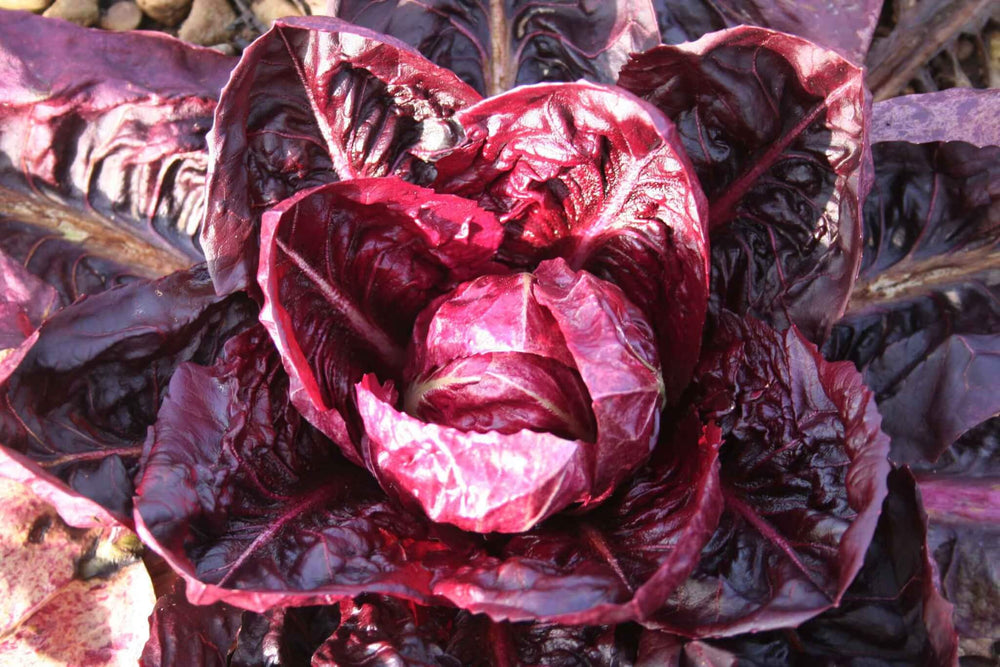Radicchio, or red chicory, adds color to your garden and dinner table. This vegetable is used widely in Italy, where at least 15 varieties are grown. Wine-red leaves have white ribs infused with tangy taste. Radicchio is an Old World chicory, a frost-tolerant vegetable that can be mistaken for cabbage. In fact, growing radicchio is much like growing cabbage. Heads are small, reaching a size between an orange and a grapefruit. Cool weather sweetens leaf flavor.
Quick Guide to Growing Radicchio
- Plant radicchio during the cool weather of early spring and fall.
- Space radicchio plants 8 to 12 inches apart in an area with full sun—but offer afternoon shade if you're growing during the summer.
- Improve native soil by mixing in several inches of aged compost or other rich organic matter.
- Apply a generous layer of mulch to keep soil moist and block weeds.
- Give plants 1 to 1.5 inches of water weekly to prevent radicchio from becoming bitter.
- Shortly after planting, start feeding radicchio with a water-soluble plant food.
- Harvest leaves when they are large enough to eat. Heads are ready to be picked once they are firm (approximately 60 days after planting).
Soil, Planting, and Care
Radicchio grows best during the cooler seasons—spring and fall. Set plants in the garden in early spring (as soon as soil can be worked). For a fall crop, tuck plants into soil in midsummer in colder zones and early fall in regions with mild winters. Radicchio grows best in full sun during cooler weather; in summer, plants benefit from afternoon shade. Established plants can withstand frost.
When planting, space plants 8 to 12 inches apart. If you know you like radicchio, you'll want to plant 5 to 6 plants per person. Mix plenty of organic matter into soil prior to planting time, or amend it by mixing in Miracle-Gro® Performance Organics® All Purpose In-Ground Soil with the top few inches of soil to improve soil texture and add nutrients. When planting radicchio in pots, fill them with a premium quality potting mix such as Miracle-Gro® Potting Mix for best results. Like lettuce, radicchio is shallow-rooted and benefits from consistent soil moisture—and organic matter helps to hold moisture in soil. Infrequent watering increases bitter flavor of leaves and also causes uneven growth. Irrigate plants deeply, providing roughly 1 to 1.5 inches of water per week. The most critical watering period occurs 7 to 10 days before heads mature. Mulch soil around plants to retain moisture and limit weed growth.
Throughout the growing season, fertilize radicchio plants with Miracle-Gro® Performance Organics® Edibles Plant Nutrition Granules, following label directions. Avoid over-fertilization with nitrogen, which can cause plants to bolt and become intensely bitter. Heads form best in cool weather; cooler temps sweeten leaf flavor. In all but the coldest regions, allow crowns to remain in soil after harvest. Mulch the crowns as cold weather settles in. Plants may produce a second harvest in spring and will likely do so in milder climates.
Troubleshooting
Some varieties of radicchio tend to bolt but our round Red Chichory variety is bolt-resistant. Most gardeners find that radicchio grows with few problems.
Harvest and Storage
Harvest individual leaves any time. Heads are ready for cutting when they're firm to the touch (usually after about 60 to 65 days), similar to iceberg lettuce. To harvest, cut the entire plant just above the soil line. Harvest heads when they're young, picking at whatever stage you want: kiwi, orange, or grapefruit size. Older heads become more bitter and tough. Don't expect all heads in a crop to form at the same time.
Once heads reach maturity, they won't continue to enlarge but will instead develop a core, the start of a flowering stem. When this core forms, flavor becomes intensely bitter. Fall-grown crops hold heads better and longer than spring-grown plants. When stored in the refrigerator in a perforated plastic bag, heads typically last 3 to 4 weeks.
Plants handle fall frosts well. In cold climes, snow-covered, frozen heads can be harvested and consumed. Thaw slowly and discard outer, cold-damaged leaves.
Uses
You can eat radicchio raw or cooked, using either individual leaves or the entire head. Serving leaves with salt counteracts the bitter flavor and draws out the flavor of the high sugar content. Toss raw leaves with olive oil and salt for a simple side dish. Blend them with milder lettuces and greens for a fresh salad. Roast or grill chunks of radicchio until edges turn brown. You can even skewer entire heads and roast them on a spit. Sauté, bake, or flour and fry individual leaves. Count on radicchio to add color to pasta, soups, legumes, rice dishes, or omelets.
Raw or cooked, the bitter flavor pairs well with the acidic sweetness of balsamic vinegar. Other great flavor partners include butter, prosciutto, Italian cheeses, lemon, salami, and fresh shell beans. Use radicchio as a substitute for chicory or endive in recipes.
Core small radicchio heads, removing much of the center of the head, to create a leafy bowl for holding seafood, tuna, or chicken salad. Strongly cupped individual leaves form ideal individual bowls for serving mixed salads like fruit, potato, or seafood. On a buffet, use individual cupped leaf "bowls" to hold olives, cheese chunks, croutons, or toothpicks.







 Herbs
Herbs
 Vegetables
Vegetables
 Fruit
Fruit
 Flowers
Flowers
 Succulents
Succulents


